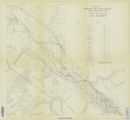| Title |
A study of primary sedimentary structures around the Moab anticline, Grand County, Utah (Thesis and maps) |
| Publication Type |
thesis |
| School or College |
College of Mines & Earth Sciences |
| Department |
Geology & Geophysics |
| Author |
Parr, Clayton Joseph |
| Date |
1965-08 |
| Description |
This study was undertaken to describe the structural development of the Moab salt anticline. Special emphasis was placed on a study of primary sedimentary structures in order to detect any influence the rising salt mass had on patterns of sedimentation during various phases of its growth. The study involved detailed plotting of current directions in the Cutler Formation of Permian Age, the Moenkopi Formation of Early and Middle Triassic Age, the Chinle Formation of LateTriassic (?) Age, the Kayenta Formation of Late Triassic (?) Age, and the Salt Wash Member of the Morrison Formation of Late Jurassic Age. The Cutler Formation has two distinct alternating lithologies. Light-orange beds of fine-grained sandstones had a northern source; they are probably eastern extensions of the Cedar Mesa Sandstone. These units interfinger eastward with purplish coarse arkosic beds deposited by high-energy streams flowing off the ancestral Uncompahgre range. Streams that deposited the arkosic beds flowed in a general northwest direction parallel to the structural trend toward a depression northwest of the main salt cell in Moab Valley. The paleodrainage pattern of the Moenkopi Formation is definitely parallel to the local structural trend; however, since the mean direction of flow conforms to the published regional direction of flow, it cannot be determined definitely whether or not the pattern was influenced by the salt structure. Thinning and pinchouts indicate that there were separate salt cells at Moab Valley and Corral Canyon about ten miles to the northwest. The number of current-direction indicators found in the Chinle Formation was insufficient to plot a meaningful pattern. Thickness variations indicate that a rim syncline developed west of Moab Valley and that slight uplift occurred just northwest of Moab Valley. The salt cell at Corral Canyon became a sharp piercement structure, and a large landslide block broke from the upturned older sediments on the flank and fell into accumulating Chinle sediments. Paleodrainage patterns and other characteristics of the Kayenta Formation indicate that salt movement had either ceased or was very localized during Kayenta time. Northwest of Moab Valley the streams of the Salt Wash Member of the Morrison Formation in general flowed unimpeded over the structure. Red siltstone particles included in an immature conglomerate along the Moab fault, together with an anomalous drainage pattern along the fault, are possible indications of activity along the fault during Salt Wash time. The site of the Moab anticline was probably determined in Pennsulvanian time by faulting that took place during the initial stages of uplift of the ancestral Uncompahgre range either just previous to or during the initial stages of deposition of the Paradox Member of the Hermosa Formation. A thick sequence of evaporites accumulated in a structural trough adjacent to the fault. The time of the first salt flowage is uncertain, but the most active period of movement was during the period from Cutler time through Chinle time. Salt movement had ceased or had become very minor by Kayenta time, and the structure was covered by the Jurassic sediments. The present anticlinal structure was formed along the ancient trend probably during a phase of the Laramide orogeny. Two stages of faulting later occurred. The first resulted in a large normal fault. Moab fault. The second resulted in collapse features around Moab Valley. |
| Type |
Text; Image |
| Publisher |
University of Utah |
| Subject |
Geology; Utah; Grand County |
| Dissertation Institution |
University of Utah |
| Dissertation Name |
Master of Science |
| Language |
eng |
| Relation is Version of |
Digital reproduction of A study of primary sedimentary structures around the Moab anticline, Grand County, Utah, J. Willard Marriott Library Special Collections, QE 3.5 1965 P37 |
| Rights Management |
In the public domain use of this file is allowed in accordance with the Creative Commons Attribution-Noncommercial-No Derivative Works 3.0 United States License, http://creativecommons.org/licenses/by-nc-nd/3.0/us |
| Format |
application/pdf |
| Format Medium |
application/pdf |
| Format Extent |
11,424,316 bytes |
| Identifier |
us-etd3,18535 |
| Source |
Original: University of Utah J. Willard Marriott Library Special Collections |
| Conversion Specifications |
Original scanned on Epson GT-30000/Epson Expression 836XL as 400 dpi to pdf using ABBYY FineReader 9.0 Professional Edition. |
| ARK |
ark:/87278/s6j397cr |
| Setname |
ir_etd |
| ID |
195040 |
| Reference URL |
https://collections.lib.utah.edu/ark:/87278/s6j397cr |









